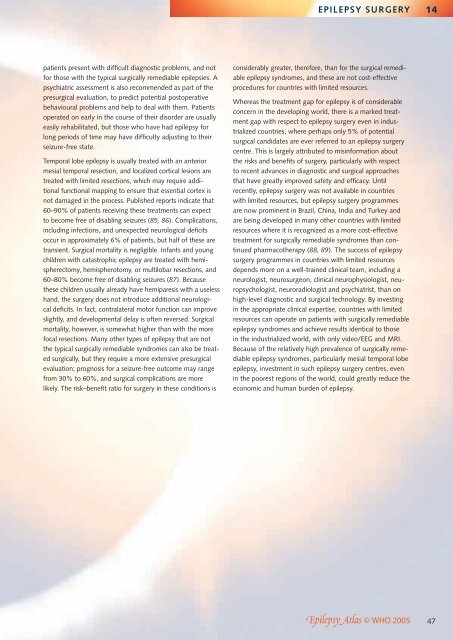Epilepsy - World Health Organization
Epilepsy - World Health Organization
Epilepsy - World Health Organization
You also want an ePaper? Increase the reach of your titles
YUMPU automatically turns print PDFs into web optimized ePapers that Google loves.
patients present with difficult diagnostic problems, and not<br />
for those with the typical surgically remediable epilepsies. A<br />
psychiatric assessment is also recommended as part of the<br />
presurgical evaluation, to predict potential postoperative<br />
behavioural problems and help to deal with them. Patients<br />
operated on early in the course of their disorder are usually<br />
easily rehabilitated, but those who have had epilepsy for<br />
long periods of time may have difficulty adjusting to their<br />
seizure-free state.<br />
Temporal lobe epilepsy is usually treated with an anterior<br />
mesial temporal resection, and localized cortical lesions are<br />
treated with limited resections, which may require additional<br />
functional mapping to ensure that essential cortex is<br />
not damaged in the process. Published reports indicate that<br />
60–90% of patients receiving these treatments can expect<br />
to become free of disabling seizures (85, 86). Complications,<br />
including infections, and unexpected neurological deficits<br />
occur in approximately 6% of patients, but half of these are<br />
transient. Surgical mortality is negligible. Infants and young<br />
children with catastrophic epilepsy are treated with hemispherectomy,<br />
hemispherotomy, or multilobar resections, and<br />
60–80% become free of disabling seizures (87). Because<br />
these children usually already have hemiparesis with a useless<br />
hand, the surgery does not introduce additional neurological<br />
deficits. In fact, contralateral motor function can improve<br />
slightly, and developmental delay is often reversed. Surgical<br />
mortality, however, is somewhat higher than with the more<br />
focal resections. Many other types of epilepsy that are not<br />
the typical surgically remediable syndromes can also be treated<br />
surgically, but they require a more extensive presurgical<br />
evaluation; prognosis for a seizure-free outcome may range<br />
from 30% to 60%, and surgical complications are more<br />
likely. The risk–benefit ratio for surgery in these conditions is<br />
EPILEPSY SURGERY<br />
considerably greater, therefore, than for the surgical remediable<br />
epilepsy syndromes, and these are not cost-effective<br />
procedures for countries with limited resources.<br />
Whereas the treatment gap for epilepsy is of considerable<br />
concern in the developing world, there is a marked treatment<br />
gap with respect to epilepsy surgery even in industrialized<br />
countries, where perhaps only 5% of potential<br />
surgical candidates are ever referred to an epilepsy surgery<br />
centre. This is largely attributed to misinformation about<br />
the risks and benefits of surgery, particularly with respect<br />
to recent advances in diagnostic and surgical approaches<br />
that have greatly improved safety and efficacy. Until<br />
recently, epilepsy surgery was not available in countries<br />
with limited resources, but epilepsy surgery programmes<br />
are now prominent in Brazil, China, India and Turkey and<br />
are being developed in many other countries with limited<br />
resources where it is recognized as a more cost-effective<br />
treatment for surgically remediable syndromes than continued<br />
pharmacotherapy (88, 89). The success of epilepsy<br />
surgery programmes in countries with limited resources<br />
depends more on a well-trained clinical team, including a<br />
neurologist, neurosurgeon, clinical neurophysiologist, neuropsychologist,<br />
neuroradiologist and psychiatrist, than on<br />
high-level diagnostic and surgical technology. By investing<br />
in the appropriate clinical expertise, countries with limited<br />
resources can operate on patients with surgically remediable<br />
epilepsy syndromes and achieve results identical to those<br />
in the industrialized world, with only video/EEG and MRI.<br />
Because of the relatively high prevalence of surgically remediable<br />
epilepsy syndromes, particularly mesial temporal lobe<br />
epilepsy, investment in such epilepsy surgery centres, even<br />
in the poorest regions of the world, could greatly reduce the<br />
economic and human burden of epilepsy.<br />
14<br />
47

















